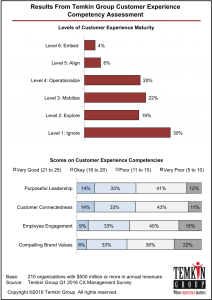
In a recent survey, 97 % of CEOs stated that customer experience (CX) was critical to their firm’s success. And, while 91 % agreed that they wanted their company to be a CX leader, nearly 40% were just taking first steps in CX.
Many companies have a lot of territory to cover to meet today’s rising customer expectations, which means starting and evolving a CX program is a pressing issue for business leaders.
When companies launch customer experience (CX) initiatives, they typically focus on implementing foundational tools to collect and measure customer feedback. As their CX programs mature, companies can adopt more advanced practices that deliver deeper customer insights.
How can companies move beyond these initial CX efforts? And which CX practices yield the best results and strongest ROI? Here are three best practices that companies should consider to maximize their CX program effectiveness:
- Implement Closed Loop Alerting (CLA) to Reach Unhappy Customers
- Apply Text Analytics to Gain Meaningful Customer Insight
- Use Positive Feedback to Recognize Exceptional Employees
Implement Closed-Loop Alerting to Reach Unhappy Customers
Closed-loop alerting (CLA) is the practice of identifying and following up with customers who have had a negative interaction with the brand. The goal of CLA is to prevent customer defections, while gleaning insights from dissatisfied customers and applying that information to drive service improvements. This helps reduce dissatisfaction and customer churn over time.
The most successful CLA programs touch 95+ % of dissatisfied customers within 24 hours. Addressing the concerns of every dissatisfied customer, though a noble goal, seems unrealistic to most brands. However, automation now enables managers to be alerted in specific cases that warrant attention, such as unusually low survey scores, and then track customer follow-ups and resolutions.
To establish a successful CLA program, companies need to focus on four essential areas:
- Process — Companies should establish a universal CLA process for the entire frontline team. Actions can vary based on company and customer need. However, effective CLA programs typically alert, via email, frontline managers when customers leave negative responses, charge frontline managers with responsibility for following up, and establish time-based goals for alert follow-ups and resolutions.
- Communication — Communicating with the customer quickly builds goodwill and makes the customer feel like their feedback is valued. This can ultimately prevent customer attrition. In a CLA program, managers also communicate with the employee who caused the customer unhappiness to prevent similar issues from arising.
- Workflow and Analytics — By analyzing the causes of alerts over time, companies can gain insight on recurring issues. In addition, companies can study trends across every level, from organization-wide down to region, branch, team, or employee.
- Metrics — Establishing key metrics and benchmarking performance helps programs gauge the evolution and maturity of their CLA practices.
Implementing advanced CX platforms can go a long way in helping companies streamline their CLA practices. However, the success of any CLA program also relies heavily on empowered managers who are held accountable for guiding their team to deliver superb service.
Apply Text Analytics to Gain Meaningful Customer Insight
In addition to soliciting closed-loop feedback, many businesses now allow customers to offer their opinions in their own words. This can deliver volumes of valuable—though unstructured–feedback. Extricating meaning from this mountain of unstructured feedback seems daunting, but yields powerful customer insight.
Software designed to sort and classify unstructured text is necessary to parse the volume of feedback entering the system. These tools make it easier for managers and CX professionals to analyze customer sentiments and identify emerging trends.
It’s important to note that only humans can adequately decipher nuances in word choice, tone, voice, and other communications features, though. For the best results, CX programs should use both text analytics software and human-based review to mine unstructured feedback.
Use Positive Feedback to Recognize Exceptional Employees
Companies may believe that the majority of customer feedback they receive is negative—but experience proves different.
Up to 55 to 65 % of the feedback many brands get from their customers is actually highly positive. In truth, this positive feedback is one of the most underutilized assets in CX programs.
CX technology makes it easier for companies to access the power of positive feedback. Employees who had a hand in delivering exceptional service can receive automated notifications or reports on high survey scores or positive customer comments. This helps boost morale and retention among top performers. Another benefit: sharing positive feedback sets examples of customer-centric behavior for other employees to follow and motivates performance improvements.
One best practice companies are now adopting is proactively congratulating employees that went above and beyond their service role based on feedback from the customer. Using features now available in leading CX platforms, managers can automatically generate and email letters of congratulation and thanks to employees. These letters can be personalized notes from a VP, CEO, or other service leader and are only sent in situations where it is clear the employee provided outstanding service in the eyes of the customer.
Make the Move to a Better CX Paradigm
With 97 percent of executives saying CX is essential to their business success, customers are top-of-mind for most companies. However, most CX programs have a long way to go toward becoming truly effective. In a study released in June 2016, CX think tank The Temkin Group found that just 10 % of companies had attained the highest two levels of CX maturity.

This creates a competitive opportunity for companies ready to make the effort to gather, analyze, and act upon customer feedback. By prioritizing initiatives that yield maximum results, companies can establish a CX leadership position in their industries. Focusing on proven practices—such as CLA, text analytics, and utilizing positive feedback—can empower companies to evolve their CX program to keep pace with customer needs.



